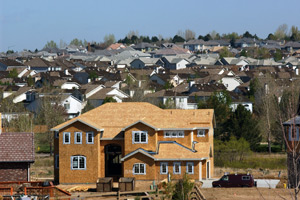Sales of New Homes Slumped in March from Seven-Year High

Purchases of new homes slumped more than forecast in March from a seven-year high, a sign progress in the industry will be halting.
Sales dropped 11.4% to a four-month-low 481,000 annualized pace, Commerce Department figures showed April 23. The median estimate of 79 economists surveyed by Bloomberg News called for a 515,000 rate.
Support for the housing market coming from better job growth and low mortgage rates is being countered by a limited supply of available homes and still-tight lending standards, creating a situation where improvement in the industry may be fitful in the months ahead. Stronger income growth for American households will be needed to further buttress the market.
“We’re recovering from the biggest housing crash, really, in the history of the country, so this is going to take time to work out,” Jay Morelock, an economist at FTN Financial in New York, said before the report.
Last month’s drop was the biggest since July 2013. The Commerce Department revised the February reading up to 543,000, the highest since February 2008. Figures for December and January also were stronger than previously estimated.
Economists’ estimates in the Bloomberg survey ranged from a sales rate of 450,000 to 550,000 after a previously reported 539,000 in February.
The Commerce Department’s report showed new-home purchases were 17.4% higher in March than the same period in 2014 on an unadjusted basis, the report showed. The median price of a new home decreased 1.7% last month from a year ago to $277,400.
The price could have been affected by a change in the regional mix of sales with purchases falling in three of four areas in March. Sales slumped 33.3% in the Northeast, which typically is among the areas with higher-priced properties. Demand dropped 15.8% in the South, the biggest decline since July 2013, and fell 3.4% in the West. The Midwest showed a 5.9% gain.
Sales of new properties, which are tallied when purchase contracts are signed, are considered a more timely measure of the market than sales of previously owned dwellings, which are counted when a sale is final.
Purchases of those homes climbed 6.1% to a 5.19 million annualized rate, the best since September 2013, figures from the National Association of Realtors showed April 22. Prices rose by the most in more than a year.
Home-value appreciation is being fueled by a constricted inventory of homes available to potential buyers. Existing homes stayed on the market a median 52 days last month, the fewest since July, according to the Realtors group, while 40% of homes sold in March were on the market for less than a month.
That creates a tough situation for first-time buyers, who often are more price-sensitive. DR Horton Inc., a Fort Worth, Texas-based builder, is trying to cater to such households through its Express Homes brand, whose homes had an average closing price of $179,000 in the three months ended March 31.
“When we put the product out there at an affordable price for those entry-level buyers and in the current mortgage environment, there is plenty of demand,” Chief Financial Officer Bill Wheat said on an April 22 earnings call. “We think that any limitations on the entry-level buyer is supply-driven.”
Stronger job growth may help demand rebound. Payrolls have grown by about 590,000 workers in the first three months of 2015, beating the 579,000 added by the same point last year, when employment grew by 3.1 million, the most since 1999.
At the same time, mortgage rates remain low, making home buying a more affordable option for some households. The average rate for a 30-year fixed mortgage was 3.67% in the week ended April 16, according to Freddie Mac in McLean, Virginia. The rate was 3.59% in February, the lowest in almost two years.
That may make buying a home a little easier for Americans who are seeing stagnant wage growth. Average hourly earnings climbed 2.1% in the year ended March, in line with the average throughout the recovery and less than the 3% to 4% increases that Federal Reserve Chair Janet Yellen has indicated are smore normal.
“Until we get much stronger wage growth, we’re not going to get a housing market that takes off,” said Ryan Sweet, a senior economist at Moody’s Analytics Inc. in West Chester, Pennsylvania.
Still, homebuilders seem optimistic about the outlook for their industry. The National Association of Home Builders/Wells Fargo sentiment gauge rose in April to a three-month high amid improved buyer traffic and a better sales outlook. More favorable weather also may ahelp the housing industry as buyer traffic picks up in the spring selling season.
New-home sales volumes typically peak in March and trail off through the year, according to Bloomberg Intelligence analyst Drew Reading.
“Recent macroeconomic and industry data suggests a more robust spring selling season and overall 2015 for public homebuilders,” he wrote in April 20 research. “Key macro drivers such as interest rates, job growth, household formations and mortgage applications are all improving.”


